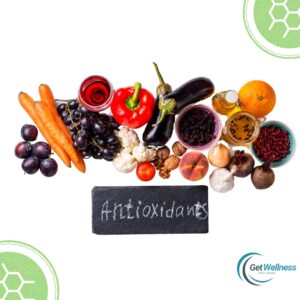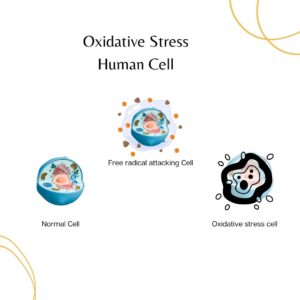Antioxidants foods

Introduction:
Antioxidants are available in different food sources. They are required to balance free radicals and protect cells from oxidative stress. Free radicals damage cells through oxidative stress. Antioxidants
Oxidative Stress:
Oxidative stress happens in different ways; we are unaware of how it will attack us. They attack in multiple ways, but mostly, we cannot recognize them and their sources. Oxidative stress can cause a variety of diseases and disorders by damage at the cellular level. While we cannot escape from oxidative stress, we can minimize its effect. There are multiple ways to reduce free radicals and their impact, every damage starts with the free radicals at cellular level. Free radicals are more unstable, and they always try to balance with other electrons. A deficiency of electrons can cause remarkable damage to the cell structure, and to prevent this, we need antioxidants.

Different types of ROS:
A lot of awareness is needed among people on antioxidants, so precautions and awareness are much needed because they minimize cellular damage. But we are all occupied by a busy lifestyle, surrounded by pollution, chemical foods, frozen foods, radiation, stress, and anxiety. In our busy lives, we mostly neglect the effect of free radicals and the availability of their source due to a lack of awareness. Oxidative Stress
Metabolic oxidative stress continues the process in the body. Because there always required body cells continue metabolism and its function. In this process of metabolism produces some waste metabolites and free radicals, this is causes the metabolic damage. This oxidative stress damages the cellular level of organelles like DNS, proteins, Golgi operations, Mitochondria, etc.

Antioxidants are which balance the free radicals and protect the cellular damage. So, this helps to mimic the oxidative damage, Antioxidants are available in fresh vegetables and fruits. Apart from dietary intake, we also need good exercise, sufficient hydration, rest, and avoiding stress. Chronic disorders can able to accelerate oxidative stress more comparatively with healthy individuals. For this reason, any chronic or acute disorders have a chance of more oxidative stress. For that needs more antioxidants.
In some individuals, we often observe the loss of hair, wrinkled skin, black spots on the skin, weakness, and symptoms of some disorders, these are all due to oxidative stress, if we take sufficient antioxidants we can improve our quality of life.
Endogenous Antioxidants:
Superoxide dismutase: This helps to reduce the damage to superoxide radicals
Catalase: This enzyme helps to convert hydrogen peroxide into water and oxygen
Glutathione peroxide: Reduces the hydrogen peroxide and lipid peroxide
Endogenous Antioxidants:
Vitamin C is a water-soluble antioxidant and vitamin that also reduces oxidative stress. Vitamin E is also another antioxidant and fat-soluble vitamin that helps to protect the cell membranes from oxidative stress, and coenzyme q10, glutathione, and Astaxanthin, like many types of antioxidants, are available
Helps to reduce chronic diseases: Oxidative stress is relevant to chronic diseases like heart disease, Cancer, Diabetes, and neurodegenerative disorders. The antioxidants help to reduce the risk
Aging process: When oxidative stress increases aging also increases, the capacity of body cells and their metabolism deteriorate with the oxidative stress, and increases in antioxidants can slow down the aging process.
Listed below are some antioxidants and their ORAC values. Antioxidants capacity per 100 grams
| S.no | Antioxidant Source | ORAC Value As per (μmol TE/100g) |
| 1 | Astaxanthin | 3,000,000 (in vitro antioxidant) |
| 2 | Glutathione | Endogenous (body) |
| 3 | Anthocyanins | 14,697–20,300 (ORAC Value) |
| 4 | Epigallocatechin Gallate (EGCG) | 1,253 (ORAC Value for green tea) |
| 5 | Cloves | 2,90,283 |
| 6 | Sumac Bran | 3,12,400 |
| 7 | Dried Sorghum Bran | 2,40,000 |
| 8 | Cinnamon | 1,31,420 |
| 9 | Oregano (Dried) | 1,75,295 |
| 10 | Turmeric | 1,27,068 |
| 11 | Acai Berry | 1,02,700 |
| 12 | Dark Chocolate (70-85%) | 20,816 |
| 13 | Pecans | 17,940 |
| 14 | Elderberries | 14,697 |
| 15 | Cranberries | 9,090 |
| 16 | Goji Berries | 3,290 |
| 17 | Blueberries | 4,669 |
| 18 | Blackberries | 5,905 |
| 19 | Pomegranate | 4,479 |
